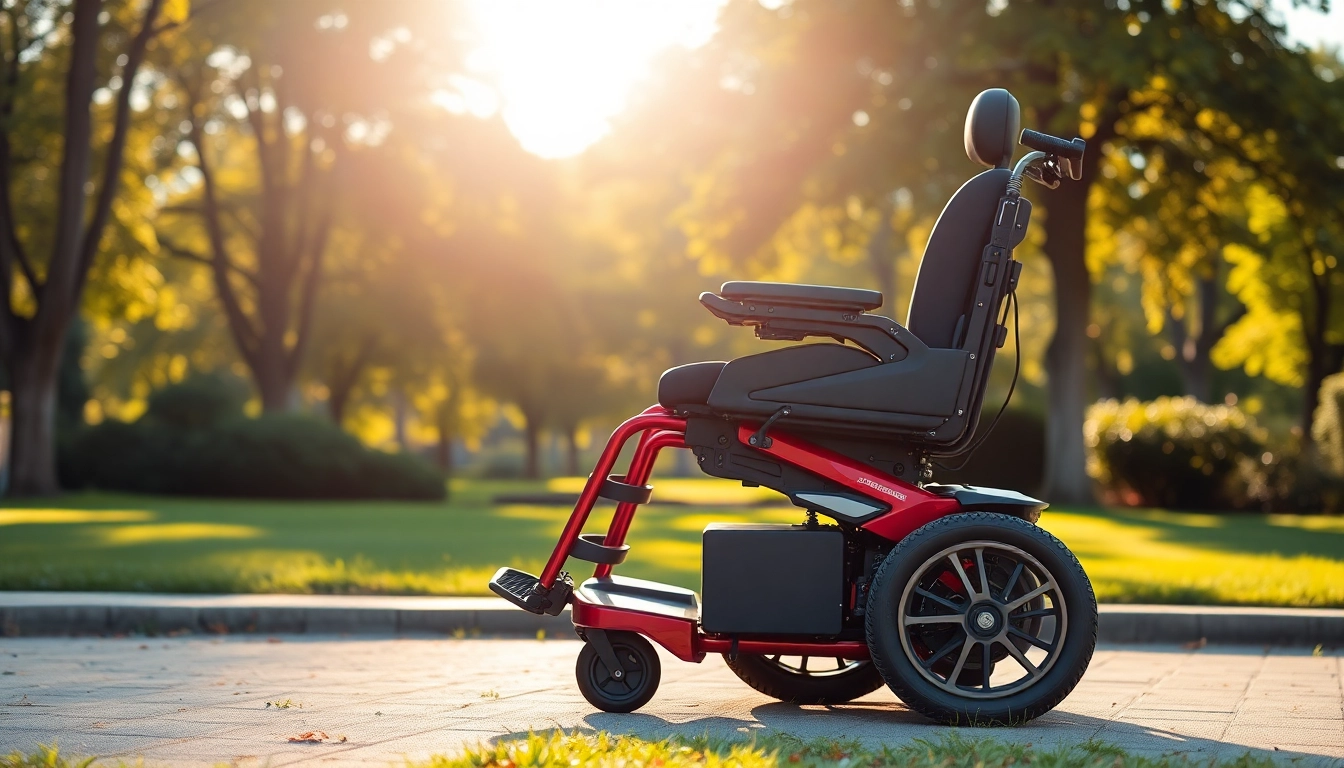Understanding Power Wheelchairs
What is a Power Wheelchair?
A power wheelchair, often referred to as an electric wheelchair, is a mobility device that is powered by a battery. Unlike manual wheelchairs, which require physical effort to propel, power wheelchairs are equipped with an electric motor that allows users to navigate with ease using a joystick or other control mechanisms. These devices have become essential for individuals with mobility impairments, providing them with the independence and freedom to move around their environments with minimal physical exertion.
Benefits of Using a Power Wheelchair
The advantages of utilizing a power wheelchair are multifold. Here are some key benefits:
- Improved Mobility: Power wheelchairs allow users to navigate both indoor and outdoor spaces effortlessly. This can be particularly beneficial in larger areas or uneven terrains.
- Enhanced Comfort: Many models come equipped with various seating options and adjustable features that cater to an individual’s comfort needs, making long-term use more enjoyable.
- Less Physical Strain: For individuals with limited upper body strength, the electric mechanism reduces the physical effort needed to move, preventing fatigue and potential injury.
- Versatile Control Options: Power wheelchairs often include customizable control systems, allowing users to operate their devices through different methods, such as switches and touchpads.
- Greater Independence: With increased mobility comes enhanced independence, as users can transport themselves without needing assistance, promoting a self-sufficient lifestyle.
Types of Power Wheelchairs Available
Power wheelchairs can be classified into several categories based on their design and functionality. Here are the most commonly available types:
- Standard Power Wheelchairs: These are designed for everyday use and offer basic features for navigating indoors and outdoors.
- Heavy-Duty Power Wheelchairs: Built to support higher weight capacities, these models are ideal for larger users, often with reinforced structures for durability.
- Portable Power Wheelchairs: Lightweight and designed for easy transport, these wheelchairs can often be disassembled or folded for travel.
- All-Terrain Power Wheelchairs: Featuring larger wheels and advanced suspension systems, these models are tailored for outdoor use on varied terrains.
- Power Tilt and Recline Wheelchairs: These specialized models offer the option to tilt the seat or recline the backrest, which can assist with pressure relief and comfort for users who spend extended periods seated.
Key Features to Consider
Battery Life and Range
When selecting a power wheelchair, battery life and range are critical factors to consider. Most models offer varying distances on a single charge, typically ranging from 10 to 25 miles, depending on usage, terrain, and weight. Users should factor in their daily travel needs and choose a model that can reliably accommodate those distances without needing frequent recharges.
Additionally, the type of battery—lithium-ion versus lead-acid—can impact performance. Lithium-ion batteries are often lighter and provide longer life spans between charges compared to traditional lead-acid batteries, making them a preferred choice for many users.
Weight Capacity and Size Options
Weight capacity is another vital consideration when selecting a power wheelchair. Most standard models support weights between 250 and 300 pounds, while heavy-duty models can accommodate significantly more, sometimes exceeding 600 pounds. Choosing a wheelchair that aligns with personal weight requirements ensures safety and durability.
Size is also important; individuals should ensure that the wheelchair fits comfortably within their living spaces, including doorways and hallways. Many manufacturers offer customizable options that allow users to select the right fit based on their measurement needs.
Control Systems and Ease of Use
Control systems vary among power wheelchairs, and finding one that is intuitive and easy to use is imperative. Most power chairs utilize joystick controls, but alternatives such as sip-and-puff controls or head arrays are available for individuals with specific needs. It’s important to test these controls to ascertain which method is most comfortable and manageable.
Moreover, features such as programmable speed settings and reverse controls can enhance user experience, making it easier to navigate through tight spaces or crowded areas.
Power Wheelchair Purchase Guide
Where to Buy a Power Wheelchair
Purchasing a power wheelchair can be done through various avenues. Local medical equipment suppliers typically offer a selection of power wheelchairs along with the benefit of professional consultations. Online retailers also provide a wide range of choices and often feature customer reviews, which can be helpful in the decision-making process. Additionally, contacting rehabilitation centers or hospitals might yield leads on reliable suppliers.
Financing Options and Insurance Coverage
Affording a power wheelchair may require exploring financing options. Many insurance plans may cover parts of the costs, depending on the owner’s medical needs and diagnosis. It’s essential to verify plan specifics and seek pre-authorization where necessary.
Additionally, several organizations and grants exist that cater to individuals requiring mobility assistance, and these can offer substantial financial relief. It’s worthwhile to research available resources in the local community.
What to Look for in a Seller
When selecting a seller for a power wheelchair, several factors can indicate a reliable provider:
- Reputation: Check for reviews and testimonials from previous customers to gauge their level of service.
- Service Offerings: An ideal seller should offer comprehensive services, including repair, maintenance, and user training.
- Return Policy: Ensure that the seller has a clear return policy in place, allowing for potential exchanges if the product does not meet needs.
- Professional Staff: Knowledgeable staff can provide invaluable advice and support through the selection process.
Customizing Your Power Wheelchair
Add-On Accessories for Comfort and Utility
Power wheelchairs can often be customized with a variety of accessories that enhance comfort and utility. Common modifications include:
- Seat Cushions: These can help prevent pressure sores and improve overall comfort during long periods of sitting.
- Armrests: Adjustable armrests can enhance user experience, allowing for better positioning and support.
- Storage Solutions: Pouches and baskets can be affixed for carrying personal items, making outings more convenient.
- Weather Protection: Covers or canopies can shield users from rain or sun, making outdoor travels more comfortable.
Personalizing Controls and Settings
Most power wheelchairs offer some level of customization regarding controls and settings. Users can tailor speed, turning radius, and sensitivity of the joystick or alternative control methods to best suit their tactile preferences. Personalizing these settings can greatly enhance both comfort and control, allowing for a smoother navigation experience.
Maintenance Tips for Longevity
To ensure optimal performance and longevity of a power wheelchair, regular maintenance is essential. Here are some best practices:
- Regular Cleaning: Keeping the wheelchair clean, particularly around the wheels and battery connections, prevents dirt buildup and improves function.
- Battery Maintenance: Charge the battery according to the manufacturer’s guidelines. Overcharging or running it completely dead can shorten its lifespan.
- Check Tires: Regularly inspect tires for wear and ensure they are properly inflated to avoid complications while navigating.
- Professional Servicing: Schedule annual inspections with a trained technician to ensure all systems are functioning correctly and to address any wear and tear.
User Experiences and Testimonials
Real Stories from Power Wheelchair Users
User experiences can provide valuable insight into the practicalities of owning a power wheelchair. Many users highlight the freedom and independence they have gained since acquiring their mobility device. For example, one user remarked that he could finally attend family gatherings without relying on others for transportation, granting him a sense of belonging and participation that had been lacking.
Common Challenges Faced by Users
Despite the many benefits, users may encounter challenges. Some report difficulties in finding adequate charging stations while out and about, which can limit travel options. Others express concerns about accessing certain venues that may not be fully accessible. It’s important to be proactive in researching locations and accommodations when planning outings.
Advice for New Power Wheelchair Owners
For those new to power wheelchairs, several tips can enhance the experience:
- Take Your Time: Becoming accustomed to operating a power chair can take some practice; there’s no rush.
- Explore User Groups: Joining local or online communities can offer support, advice, and shared resources that facilitate a smoother transition.
- Seek Training: Many dealers provide user training on the controls and features of the wheelchair, which can be incredibly beneficial.



